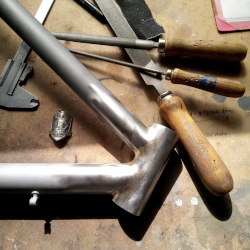
The difference is enormous and substantially is that the tig melts the metals to be joined, while the fillet brazed "glues" them with the contribution of a metal alloy with a lower melting point.
The latter is in turn divided into two types, frame with conjunctions and frame without conjunctions
After saying this, the passionate cyclist's question arises: Which of the three is the best method?
Let's analyze the different methods and draw conclusions. Today the new steel alloys have exceptional breaking loads and therefore the companies that produce pipes for cycling use can make pipes with very thin thicknesses, less than half a millimeter and through suitable heat treatments they can resist high stresses in a span of time. very long (something unthinkable with aluminum or carbon frames).
The tig as we said must melt the metals to join them therefore it brings the temperature above 1450 ° C and in part alters the balance of the metal and theoretically weakens it, in fact on all frames welded with tig, regardless of the type of material (aluminum , steel, titanium) breakages occur just after the weld seam.
frame breakage due to tig welding
Being a "bonding" the fillet brazed does not melt the metals to be joined therefore it does not alter the balance or at least does it to a much lesser extent, this depends on the type of alloy / material used to join the pipes.
The alloys commonly used are with silver percentages ranging from 5% (the most used) up to 60% silver (the least used), therefore temperatures ranging from 850 ° C to about 550 ° C. The higher the percentage of silver the lower the "bonding" temperature, therefore less stress on the pipes but more stress on the pocket being very expensive.
Few craftsmen use alloys with 50-60% silver and their method advertise it with the wording "Silver Fillet Brazed".
I conclude with the pros and cons.
Frame in tig
Pro: ease of processing, cleaning, lightness, freedom of geometry.
Contro: possible breaks with very thin pipes.
Fillet brazed frame, without conjunctions
Pro: stiffer than the tig, it does not alter the balance of the pipes, pleasant to look at (it looks like a monocoque), freedom of geometries such as the tig.
Contro: slow processing, more expensive, a few tens of grams heavier.
Fillet brazed frame, with conjunctions
Pro: undisputed retro charm with worked and chromed conjunctions
Contro: slow processing, more expensive, constrained in the choice of corners.








 Every frame I craft is tailored to your unique needs and preferences, ensuring a perfect fit and unmatched performance
Every frame I craft is tailored to your unique needs and preferences, ensuring a perfect fit and unmatched performance